114-68-100 r=16.5m @ 180cm

Manufacturer Info:
Desmond Custom Skis
313 College Hwy
Southampton, Massachusetts 01073
http://www.desmondskiworks.com/
Suggested Retail Price (MSRP):
$725usd
Usage Class:
GS "Cheater" frontside carver
Rating (with comments):
(1="get me off these things"->10="I have to own a pair")
9+ Technical hardpack or packed powder carving - it keeps growing on you more and more
8 - Mixed surface conditions, crud busting...a bit stiff for bumps.
6 - Powder (it's a hardpack tool, but not bad at high speeds)
Background:
Desmond Ski Works is a one-man craft workshop producing only a few pairs of skis per year in New England. Far from being a "garage brand", Steve produces really impressive work and is a great example of the craft ski builder you can find in workshops all over the World putting their hearts and hands into their creations. Steve Desmond works to incorporate eco-friendly components such as Entropy resins, flax in place of fiberglass, cork, renewable wood veneer topsheets and ipe wood sidewalls into his designs.
Manufacturer's Description:
"This is a GS style ski or cheater ski. Made for groomer or hard pack conditions and carving."
Technical Ski Data:
In Steve's own words:
"180cm 114-68-100 16.5 meter radius. The wood core is ash under the binding area mated to poplar fore and aft. Sidewall is variable width Ipe. Laminates are flax by Bcomp, cork damping layer, VDS over the edges and over 2 sheets of titanal. Top sheet is book matched Chen Chen. The finish is exterior grade water based polyurethane by Deft. Head FreeFlex 14 bindings. The edges have a 1 degree on the base and 3 degree on the side. Skis are detuned at least 6 inches back from where the tip starts and about a finger length on the tail."
Bindings, Boots & Wax Used:
Tyrolia PRD 12 bindings
Salomon S-Max 130 Carbon boots.
Salomon X-Pro 130 boots.
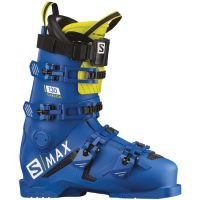
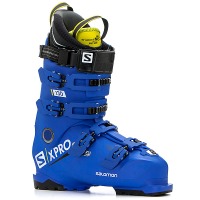
Pre-Skiing Impression:
The Desmond GS Comps are stunningly beautiful with their richly grained Chen Chen veneer and gleaming ipe sidewalls coated with a polyeurethane finish. Fit and finish are impressive, with a bit of concave base over the tail inserts (Steve knows about this condition on these demo skis and acknowleged customers would not get skis with this kind of defect, even if it doesn't affect the performance in any way). The mating edges of the sidewalls and sandwich layer components are really well finished and show consistent accuracy in the layup. The flex is balanced with moderate stiffness at the forebody leading to a rock-solid midsection and moderately strong and even curve into the tail section. Torsional strength feels like a race ski with a bit more compliance in the tips. Rebound is strong and well dampened. These feel like serious frontside racecarvers bordering on race-like personality. Eastern hardpack enthusiasts instantly got excited over the geometry and flex of the Desmond GS Comps when they saw them. Several different hard-core ski geeks gasped when told Steve only charges $725 for them...everyone thought he should charge around $1,100 - $1,300 for skis like these.
Test Conditions:
Perfect Eastern hardpack, boilerplate, high and low density packed powder conditions, with some firm bumps and shin-deep dry powder.
Summary:
The Desmond GS Comps immediately impressed us and quickly grow on the skier the more and more you ski them. My first runs on the flawlessly firm Worden's NCAA race trail at Dartmouth Skiway had me understanding the ski's turn behavior in about 3 turns, then instantly began to press them harder and harder at higher edge angles and speeds until I booted-out due to the lack of riser plate under the Tyrolia PRD bindings. The addicting smoothness and elegant turn shape with high pressure capabilities were addicting, and being dead-quiet and secure at speed made it nearly impossible to find the upper speed limit for the Desmonds. They ski a bit shorter than they measure.
Carving afficianados and ex-racers (or current beer league racers) will find the Desmonds superbly suited to satisfying the addiction to holding a line at speed across hard surfaces and changing that line quickly to change direction. These Desmonds have a good range of turn radius they're comfortable with, and they deliver a round, smooth arc. As our tester Brian Finch commented, the lack of plate under these GS cheaters means the midbody of the ski is compliant and wants to round-out a turn rather than pivot quickly underfoot, so you could tune the personality of this platform with various types of plates and get good results. Vibration control is excellent without feeling dead underfoot, and you get really nice communication about the surface density and texture without any annoyance or feeling isolated. These Desmonds have a great balance of flex, power, dampening and geometry to deliver GS-like turns (or tighter) at moderate to high speeds with superb confidence and accuracy, all in a gorgeous package at a bargain price. Needless to say, we loved this ski and would put a pair into our quiver in a heartbeat.
Hardpack and Boilerplate:
The Desmond's have a natural affinity for hardpack and they shine when you put them on-edge and apply pressure to bend them onto the surface. They feel just a bit unexciting at low speeds, but get them into a moderate rate of speed and set their edge and they become eager for more...more...more. Once you go from casual carving to "let's get to work" mode, the Desmonds feel like they come into their element, responding eagerly. That's what you want from a racecarver. Their natural arc on hardpack is elegantly smooth and rounded, naturally inviting the pilot to link turns at speed from intensely flexed edge into the next turn sequence with total confidence and quiet authority. The Desmonds are not radical, high-tension explosive devices, but smooth and confident tools for technicians who crave arcs on hard surfaces with security and speed. Vibration control on hardpack is superb without the skis feeling deadened, although a bit more "zip and zing" out of the ski at the end of the turns would be icing on the cake...depending on your preference for carving ski behavior. These are an Eastern skier's high-performance cruising weapons capable of taking you from first-chair high-speed wakeup runs on flawless groomers at intense angles to beer league on Thursday nights.
Mixed Surface & Variable Conditions:
The Desmond GS Comps are narrow-chassis skis at 114-68-100 (don't expect a lot of float), but their rock-solid tracking ability with zero deflection and excellent dampened action mean they can cut through crud and cut up junk surfaces without effort. You won't get surfy behaviors out of them, but these Desmonds let you arc through mixed surface conditions on a purely directional line with complete authority, and the more you drive them, but more solid they become underfoot. Their relatively quick edge-to-edge ability means you can change directions without a whole lot of mental preparation, and the ski will change directions, preferably on-edge rather than flat-on-base. Irregularities and undulations (including small bumps), are inconsequential, and you just head straight into them and forget about any chance of getting knocked off line. This doesn't mean the Desmonds are burly and rough in mixed conditions, they are smooth and confident without beating up the skier, making them totally at home as an all-mountain frontside carver, even after some fresh snow overnight. The only drawback might be a slight feeling of heaviness in snow conditions over 6 inches at slower speeds, which disappears as you pick up your pace.
Powder Conditions:
Really, you want to take a 66mm underfoot ski with two sheets of metal into powder? You can do it, but the deeper the snow gets, the faster you need to go to reduce the feeling of driving your Bianci road race bike in a sandpit.
Turn Initiation, Apex & Finish:
The Desmond GS Comps have a natural, progressive turn process leading from a gentle roll of the ski on-edge which engages the forebody right near the shovels into a progressively stronger pull across the slope with a deepening bend into the midbody underfoot where rock-solid grip comes through. Maintaining pressure through the turn with an increasing or decreasing amount of edge angle produces a pretty nice range of finishing radii onto a solid tail with rounded finish...all with a smooth, smooth feel and response with excellent feedback about the density of the surface under the ski. Steve has done his homework on the geometry and flex of these skis, and it shows. Testers remarked on the affect of the as-delivered tune on the skis and we had some suggestions to improve it to get even more exciting turn behaviors out of them, but since tune specs on hardpack carvers is a personal matter, we leave that up to the afficianos who would want this ski. The degree of acceleration from the Desmonds is deceptive, since they don't "explode" out of the turns but generate a strong, and sometimes surprising flow of energy into the next arc. Some skiers wanted a bit more excitement and snap, others thought it was just right.
Manufacturer's Mounting Position:
We adjusted the Tyrolia PRD bindings fore and aft a few cm, and found 1-2 cm behind the stock mounting position felt best for the racer-types on Eastern hardpack surfaces.
Analogies: ("This ski is like...")
An Aston Martin coupe with beautiful wood treatments you take to the track for club racing.
Notable Tester Comments:
Brian Finch:
"The Desmond Carver was quite a surprise. It actually skied quite short it had a very round profile throughout and what was interesting was that with a little bit of modification of stance I was able to let it straight line without trying to move into a pure around arc. I took them out with my World Cup boots that were stacked by about 11 mm to avoid boot out. I do think in RDX place would be perfect for this. I was a little bit surprised that the smooth flex without a speed limit did not allow this ski to pivot efficiently as I thought it would. It really didn’t wanna hook up because of how compliant it was.
When I heard the retail price was only $725, I thought that was ridiculous since that quality should probably be priced somewhere in the $1300-$1400 range. I did note that the base was acceptable but not incredibly well structured at allowing you to efficiently slide the skis and dynamically turn them. When I got to test them, they did not have a stellar tune, and I was quite surprised that they held as well as they did with such edges.
I'd express some caution when purchasing these Desmonds and I believe the builder would do very well by explaining the sizing of the ski. I’m guessing that this was approximately a 185 and it felt like it skied probably 10 to 15 cm shorter. I’m not really sure what a larger skier would think of that. I did find that on the Desmond Carver moving the binding back about a centimeter and a half was perfect. I generally find that a half to a full centimeter behind the line is where I like to be set up, so I would say that should be taken into consideration as well. This has more to do with my body habits and dimensions but I do think it’s slightly forward from the best mount line.
This ski would be very interesting to see with the plate on it. The very round flex could be reduced a little bit and it may actually pivot a little bit better with a firmer spot underneath. overall it’s a really stellar ski."
Quick Comments:
- Absolutely beautiful
- Impressive workmanship
- Hot-rod performance at speed
- Addicting and have a "grow-on-you" quality
Things I Would Change About This Ski:
Definitely add a short-to-moderate raceplate to prevent boot-out. The Tyrolia PowerRail plate might be ideal to put under the bare PRD bindings Steve provided on this pair....or maybe even a full-on raceplate for maximum high-angle antics for racer-types who want a more rock-solid, slightly hinged effect in the flex pattern. It doesn't need a heavy-rubber style plate..just some height because of the angles the ski craves.
Short Answer When Someone Asks "What Do You Think About This Ski?":
Gorgeous craft-made ski with serious carving chops at moderate to high speeds. Simply cool and addictingly good at what it does.
What kind of skier is this ski good for and not suitable for?
Hot-rod intermediates and technical experts who haunt the frontside groomers early in the morning are ideal candidates for this ski.
Passive civilian skiers will find they might have picked too much ski for their skill levels.
Advice To People Considering This Ski:
If you love high-speed GS turns, don't be afraid to size up a notch.
Buy a moderate plate for any binding with low stand height...you'll thank us later.
Other Reviews:
None found.
Pics: (click for larger versions)

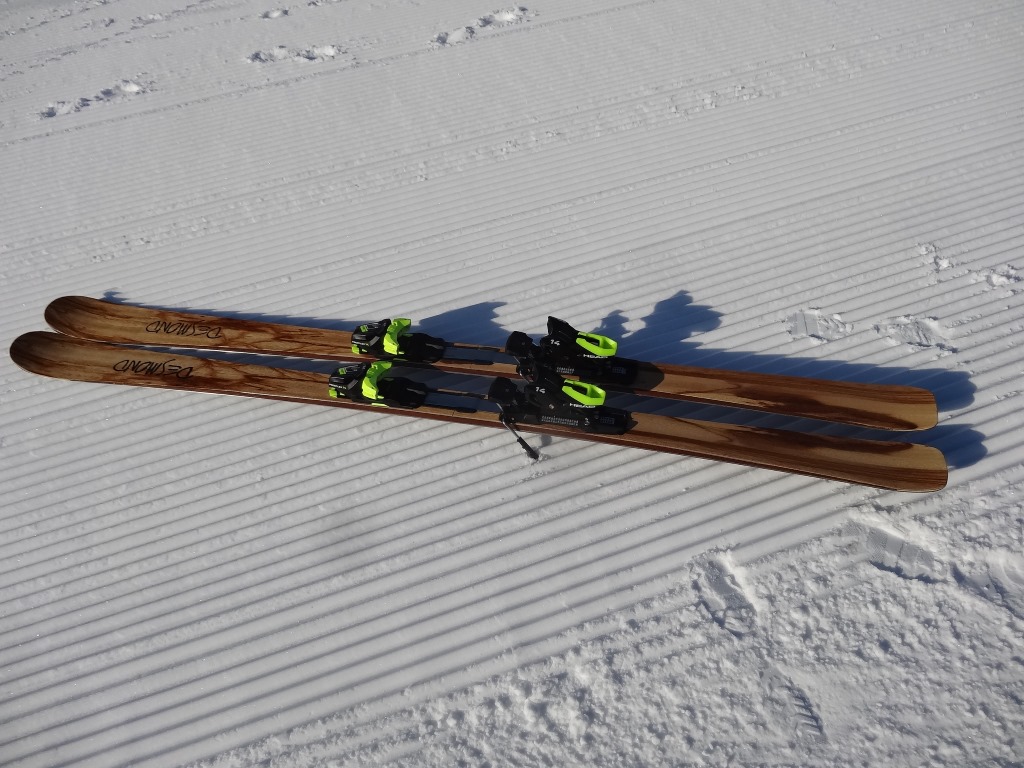

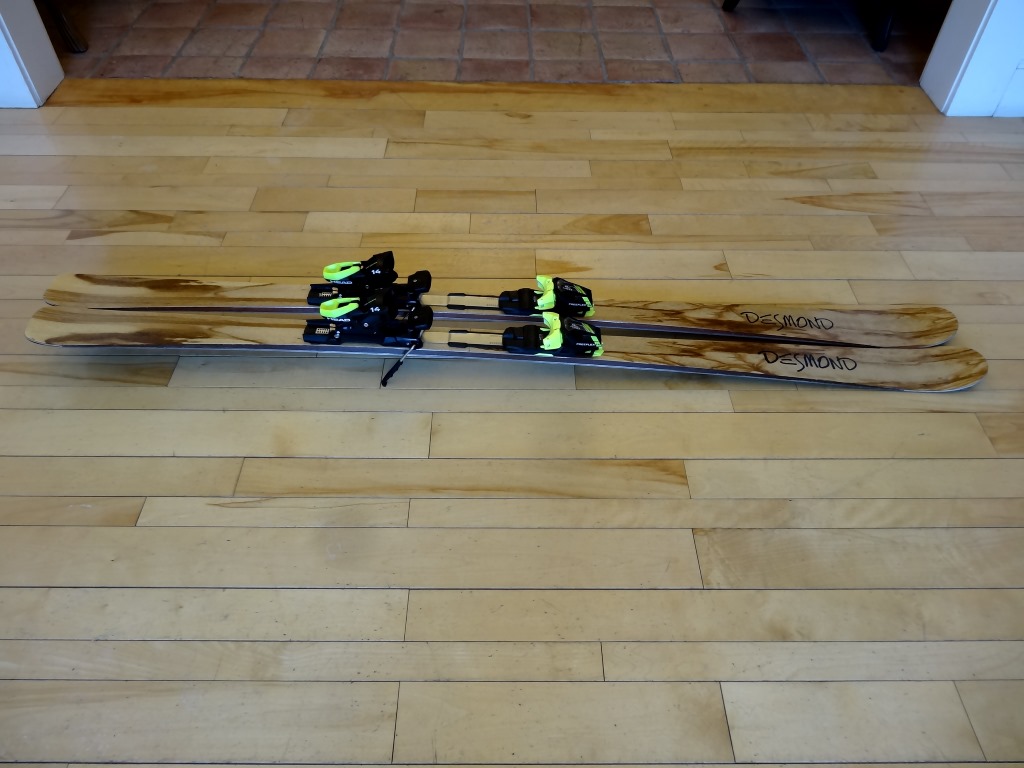

Desmond GS Comp Tail Insert Detail

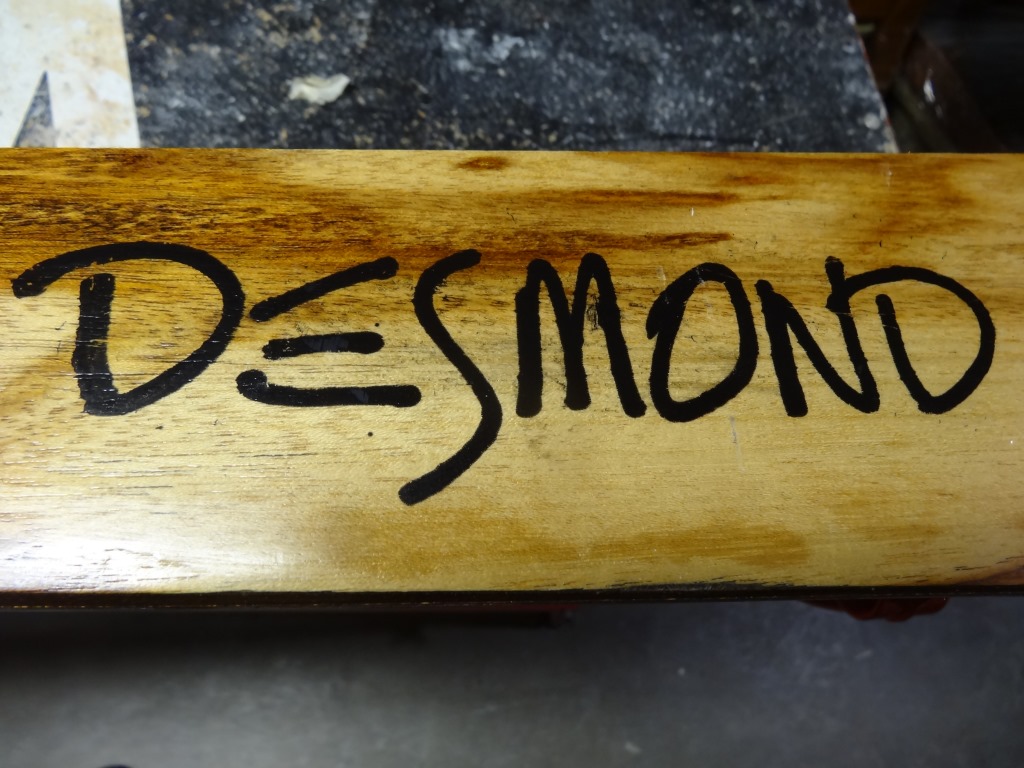
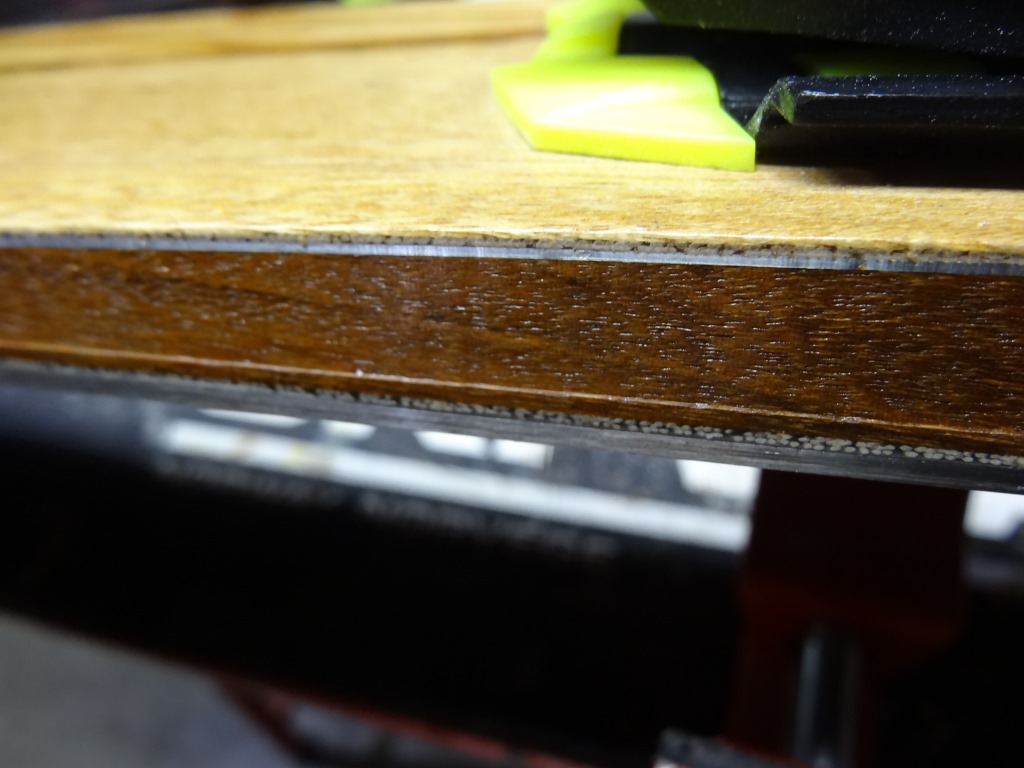

Desmond GS CompTip Insert Detail

Desmond GS Comp Tail Insert Detail

